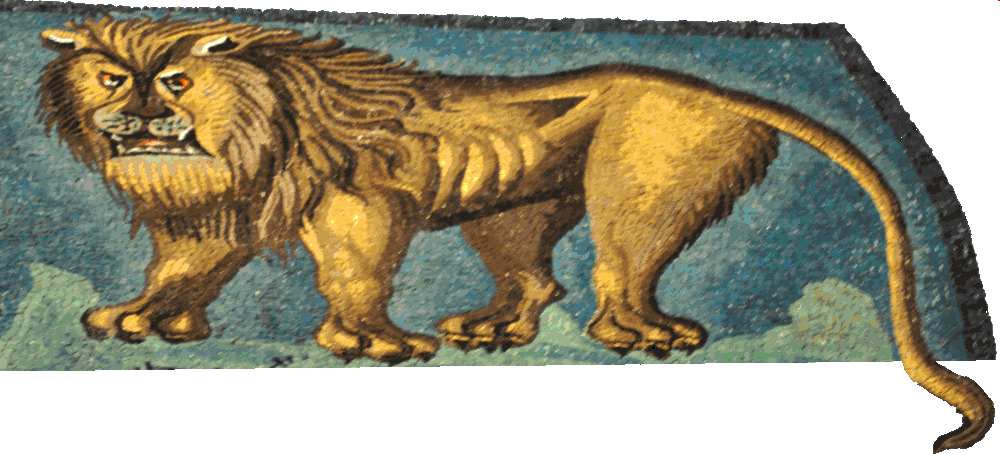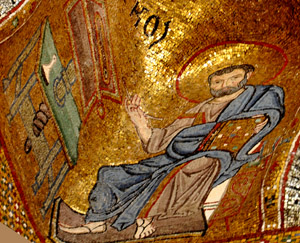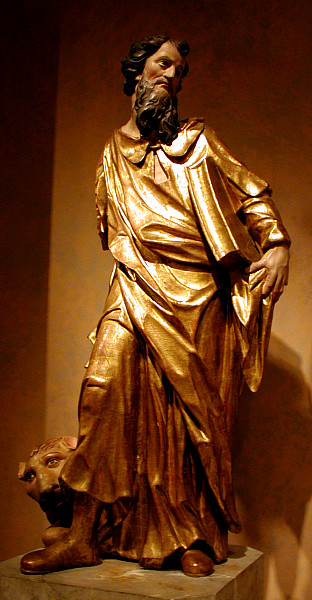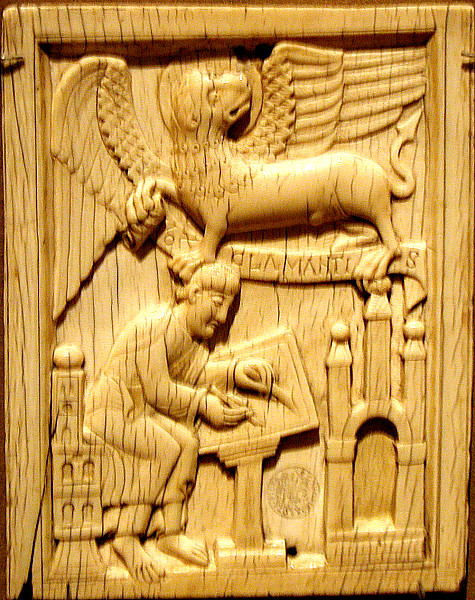
|
Saint Mark: The Iconography
In Alexandria the natal day Not his birthday but the day he died and was "born again" into Heaven of blessed Mark the Evangelist. This disciple and interpreter of the Apostle Peter wrote his Gospel on the request of brothers in Rome. When that was done he went to Egypt, the first to preach Christ there, and established a church. Later he was arrested, tied up, dragged over rocks, and severely injured. Then, while he was locked up in a prison an angel came to comfort him and then the Lord himself appeared and called him to Heaven in the eighth year of Nero's reign. – Roman Martyrology for April 25 |
SHOWN ABOVE
|
The New Testament has eight passing references to a man named Mark or John Mark, including one where St. Peter calls him "my son." Eusebius and the very earliest Christian writers believed that he wrote the Gospel of Mark on the basis of Peter's sermons in Rome, and that Peter then "authorized the reading of the book in the churches." Veronese's Sacra Conversazione with Tobias and the Angel of 1540 has Peter actually dictating the gospel to his (most likely spiritual) "son." Eusebius adds that "Mark is said to have been the first man to set out for Egypt…and the first to establish churches in Alexandria."1
That is all that can be known or surmised about the historical Mark. But the Mark of legend has a much more dramatic story to tell.
Bede put the core of the story in his influential Martyrology of 731:
In Alexandria, the commemorative festival of St. Mark the Evangelist: who … was detained by the pagans who remained in Alexandria. They, seeing him performing masses on the holy day of Easter, April 24, threw a rope around his neck and dragged him to Boukolia, the pasturage which is near the sea, under the cliffs, where a church had been constructed; and his very flesh was pouring off onto the ground, and the stones were being discolored with blood. Moreover once evening had come, they placed him in prison, where around the middle of the night, having first been strengthened by an angelic visitation, then by the Lord himself appearing to him, he was called to the heavenly realm. And in the morning, while he was being dragged to Boukolia, giving thanks and saying: "Into your hands I commend my spirit," he died and was buried with glory by God-fearing men, in a place cut out from the rock. Moreover he had ordained Annianus in his place as bishop of Alexandria: he had also given bishops, priests, and deacons to other churches, far and wide.2Almost all subsequent tellings of the story include the dragging, the bloody stones, and the two visits in prison. I have not yet seen any images of the dragging, which would be hard for an artist to picture. In a huge 16th-century canvas in Venice's Accademia Gallery Belliniano has the saint tied by ropes but being beaten to death by a man with a club. Later texts fill in Mark's adventures between his service in Rome and his martyrdom. According to one tradition that made it into the Golden Legend, Peter first sends Mark to Aquileia (image), a great city at the head of the Adriatic. Even before entering the city gate, Mark cures a young leper. Soon after, he baptizes the youth and his whole family. More miracles and conversions ensue until Mark decides to take one Hermagoras back to Rome to be ordained as Aquileia's bishop (image).3 The Golden Legend then relates another tradition, in which Peter ordains Mark a bishop and sends him to Alexandria. A relief in Barcelona portrays the ordination. Mark's first convert in Alexandria is Ananias, a shoemaker he engages after breaking his shoe on the journey. While re-sewing the shoe the man wounds his left hand, but Mark heals it with clay and spittle. The shoemaker and his family and neighbors soon accept the faith and are baptized, as portrayed in this relief from the 15th century. The Legend's source also lists the successors of Mark as bishop of Alexandria, with Ananias as the first.4 The Louvre has a high relief of what it is believed to be Mark and all his successors. But the most adventurous part of the story is the translation of St. Mark's body from Alexandria to Venice. The Golden Legend sanitizes its 9th-century source somewhat, backdating the translation to before the advent of Islam and deleting the chicaneries of the Venetian merchants who steal the body. In the source they use the cloths that have covered it in the sarcophagus to wrap the body of St. Claudia, which they then put into Mark's sarcophagus; when the local Christians get suspicious, they open the sarcophagus and believe Mark's body is still there under the cloths. The merchants then put the body in a basket, cover it with olive leaves, and top the basket up with pork so the Moslem officials at the port will wave them away without looking inside. This latter trick is memorialized in this mosaic on the west façade of St. Mark's Basilica.)5 Having suppressed these chicaneries, the Golden Legend continues with the voyage to Venice. On the way, a storm comes up at night and the sailors cannot tell where they are headed, but the saint appears to a monk on board and tells him where they can land the ship safely (image). The other mosaics on the west façade continue the story as told in the 9th-century source. The ship arrives in the Castello section of Venice and is greeted by the bishop and clergy, who take the body in procession to the ducal palace (second mosaic on the right.) The Doge and the Signoria reverence the body (second lunette from the left). Finally, it is carried into St. Mark's Basilica (First lunette on the left). Inside the basilica, on a vault above the north gallery, are narrative mosaics picturing miracles and conversions effected by the saint. The Golden Legend also relates a story that was to be memorialized in a remarkable painting by Tintoretto. A great storm wrecks a ship bound for Venice and casts the Saracen sailors into the sea. One of them vows to St. Mark that he will convert if the saint will save him. Sure enough, Mark plucks him out of the water, returns him to the ship, and calms the storm. In the earliest Christian iconography the four evangelists were represented by the "four living creatures" of Revelation 4, with the one "like a lion" representing St. Mark. (For a fuller exploration of the scriptural and exegetical sources, see the page for the evangelists.) At first, it was usual to represent Mark by a lion alone, without a human figure, as in this example from the 5th century. This example from the 6th century clearly represents the saint offering his Gospel to Christ, but it still does so without portraying him as a human person. In medieval and later art it was still possible to represent St. Mark with a lion alone (example), but even as early as the 6th-century mosaics in San Vitale, Ravenna, he was portrayed as a human with the lion as an attribute. In one image that could be called transitional were it not so late, the evangelist is a winged human form with a lion head, standing at a writing table with two books. In addition to using the lion as an attribute, portraits of St. Mark often reference his writing of the Gospel, for example by showing him at work (as in the third picture at right) or by using a pen as an attribute (example). In one miniature by the Boucicaut Master he sits at a writing stand sharpening the pen with a penknife, a winged lion at his feet and smaller furry creature (lion cub? monkey?) on the back of the stand. A lily stalk in a vase sits on his window, a common element in Annunciations but rare in images of this saint.6 Some of paintings Tintoretto did for the Ducal Palace in Venice portray St. Mark commending the prayers of the Doge – in one painting to the Virgin and in another to St. Catherine. Two 12th-century portrait groups of the Twelve Apostles make a place for St. Mark. In an apse mosaic at St. Paul Outside the Walls he replaces Peter, who has been moved to a position of greater prominence in the apse. In another apse mosaic in Cefalù, Sicily, nine of the twelve figures lined up like apostles are from the 12 in the usual list, but Mark, Paul, and Luke replace James the Less, Matthias, and Jude Thaddeus – figures of lesser interest, apparently. In both cases, St. Mark has no attributes and is identifiable only by the label placed beside his portrait. Unsurprisingly, portraits of St. Mark appear many times in the mosaics inside St. Mark's Basilica in Venice. Perhaps the most surprising of them is at the west end of the nave: a Dëesis-like mosaic in which St. Mark appears in the place usually taken by St. John the Baptist. In the Ethiopian Garima Gospels of the 4th century, one image of Mark uses a dolphin as his attribute. The few other Ethiopian images I have studied present him with writing implements instead. Egyptian Coptic images more commonly identify him with a ship and lighthouse (referencing his arrival in Alexandria), sometimes adding the more univeral lion attribute.
Prepared in 2014 by Richard Stracke, Emeritus Professor of English, Augusta University. Revised 2017-04-28, 2018-12-05.
|

St. Mark at his writing table. (See the description page.) 
German, 18th century (See description page) 
11th-century ivory (See description page) ATTRIBUTES
MORE IMAGES
ALSO SEE BIOGRAPHY
NOTES 1 Acts 12:12, 12:25, 15:37, 15:39; Colossians 4:10; 2 Timothy 4:11; Philemon 1:24; 1 Peter 5:13. Eusebius II:15 (Louth 49-50), III:39 (Louth 103f), VI:14 (Louth 192), VI:25 (Louth 201). Eusebius wrote the Ecclesiastical History before and after the turn of the 4th century; regarding Mark he cites Papias (wrote at the turn of the 2nd century) and Clement of Alexandria (lived 150-215 A.D.).2 Head, 184. 3 Acta Sanctorum, April vol. 3, 346-47, and Golden Legend #59. 4 Acta Sanctorum, ibid., 347-49. 5 Acta Sanctorum, ibid., 354. 6 This miniature is published in One Hundred Saints (53), which dates it from circa 1420, attributes it to "Boucicaut Master or Workshop," and says it is in the Morgan Library. However, I could not find it in the Morgan's catalogue. According to Andrews, "The Boucicaut Masters" (Gesta XLI [2002], 29), fifty-nine extant manuscripts have been "associated with" the Boucicaut Master. His workshop is credited with another miniature of St. Mark sharpening his pen, in the University of Melbourne's Baillieu Library. That work, which is of considerably less quality, is reproduced and discussed in Melzer. |